REPRINTED WITH PERMISSION FROM THE CHRISTIAN SCIENCE MONITOR
 Dora Lopez gets a hug from lead outreach worker Zaida Adams at Mutual Aid Eastie's community space, Jan. 25, 2023, in East Boston. Ms. Lopez, who was unable to work during medical treatments, sought help filling out forms for housing support. Members of Mutual Aid sat down with Ms. Lopez's landlord to work out rent issues. Melanie Stetson Freeman/Staff
Dora Lopez gets a hug from lead outreach worker Zaida Adams at Mutual Aid Eastie's community space, Jan. 25, 2023, in East Boston. Ms. Lopez, who was unable to work during medical treatments, sought help filling out forms for housing support. Members of Mutual Aid sat down with Ms. Lopez's landlord to work out rent issues. Melanie Stetson Freeman/Staff
January 30, 2023
It’s a frigid afternoon at the headquarters of Mutual Aid Eastie in East Boston, a predominantly working-class, immigrant community just across the Boston Harbor from downtown. There’s a tenants’ association meeting going on inside. Seated around a wooden dining table, members of a local housing advocacy group are helping two neighbors who have just received eviction notices decide what to do next.
The atmosphere is jovial; they speak rapidly in Spanish and sip Mexican hot chocolates garnished with homemade whipped cream. In the kitchen there’s coffee brewing. Someone’s grandchildren wait patiently at the table, playing mobile games on their devices.
Scenes like these are common at Mutual Aid Eastie’s communal space, a building donated by the local Channel Fish Co. The group – which is not incorporated as a nonprofit – holds weekly “office hours,” where neighbors can stop by to get help with complex problems like housing or food insecurity. Out back there’s a food pantry and a free library, stocked by the group’s staff. Among other services, the group has collected and distributed relief funds, advocated for immigrants in court, connected renters with lawyers and housing advocates, delivered groceries, and provided emotional healing to the East Boston community.
As the onset of the COVID-19 pandemic tested America’s social fabric in early 2020, an unprecedented number of groups like Mutual Aid Eastie sprang up across the country, aiming to support those who’d fallen through the gaps in traditional social safety nets. In Boston, loose coalitions of passionate people involved in grassroots, non-hierarchical projects set out to transform the way communities interact with one another, envisioning a society that rejects the power dynamics of charity in favor of solidarity.
 Melanie Stetson Freeman/StaffCo-facilitator Leonard "Leo" Olsen (center, standing) and lead outreach worker Zaida Adams (right) speak with visitors during office hours at Mutual Aid Eastie’s community space, Jan. 25, 2023, in East Boston. Mutual Aid Eastie is an organization where neighbors can stop by to get help with complex problems like housing or food insecurity.
Melanie Stetson Freeman/StaffCo-facilitator Leonard "Leo" Olsen (center, standing) and lead outreach worker Zaida Adams (right) speak with visitors during office hours at Mutual Aid Eastie’s community space, Jan. 25, 2023, in East Boston. Mutual Aid Eastie is an organization where neighbors can stop by to get help with complex problems like housing or food insecurity.
Three years out, many of these networks have crumbled due to limited staffing, funding constraints, and volunteer burnout. Still, proponents and scholars see value in the lingering benefits of mutual aid in communities, and wonder if the movement might have a wider influence – perhaps toward a society in which being a neighbor means more than just living on the same street.
“We’re creating this as a space for neighbors to connect with each other again,” says Leonard “Leo” Olsen, Mutual Aid Eastie co-facilitator. “To convivir, as we say in Spanish, to actually live alongside one another and support each other.”
Mutual aid, liberation, and the pandemic
In the Boston area, the pandemic saw people in nearly every neighborhood voluntarily mobilizing into grassroots groups addressing the overwhelming need they saw growing in their communities.
Mutual Aid Eastie was formed in early 2020 by a coalition of individuals from three local nonprofits – Maverick Landing Community Services, Eastie Farm, and Neighbors United for a Better East Boston – as a pandemic response.
Each street in East Boston had a “captain,” whose job it was to connect with neighbors, linking them with food and resources while they quarantined at home.
Across the harbor in the suburb of Somerville, a newly formed group called Mutual Aid of Medford and Somerville (MAMAS) had constructed a similar network, utilizing Slack messaging channels and Google docs and designating neighborhood points of contact to ensure everyone who’d lost work could feed and support themselves and their families. Similar groups soon formed in Jamaica Plain, Allston, Cambridge, Dorchester, and Brookline.
In each neighborhood, the sudden mobilization of a massive, nascent volunteer force mirrored what was happening in nearly every city in America. The pandemic, it seemed, had awakened a deep collective urge to help one another.
But the concept of mutual aid is far older. In his 1902 book, “Mutual Aid: A Factor of Evolution,” Russian aristocrat-turned-anarchist Peter Kropotkin argued that it was cooperation, not competition, that led humankind to its rung at the top of the evolutionary ladder. Human societies, Kropotkin writes, thrive not through the self-interest encouraged by capitalism, but through mutual support based on principles of reciprocity, which he calls “mutual aid.”
 Melanie Stetson Freeman/StaffCo-facilitator Leonard "Leo" Olsen and lead outreach worker Zaida Adams pose outside Mutual Aid Eastie’s community space, Jan. 25, 2023, in East Boston.
Melanie Stetson Freeman/StaffCo-facilitator Leonard "Leo" Olsen and lead outreach worker Zaida Adams pose outside Mutual Aid Eastie’s community space, Jan. 25, 2023, in East Boston.
In the United States, marginalized communities – those for whom the U.S. government was a primarily hostile entity – have historically had the most to gain from mutual aid. In the late 1700s, the Free African Society provided such support to formerly enslaved people in Philadelphia, and used the organization to consolidate the Black community’s power. Coupling aid with social agendas is a common thread throughout the mutual aid groups that have blossomed since, with many being explicitly associated with radical politics. In 1969, the Black Panther Party began its Free Breakfast for Children program, and distributed free food to urban children across the country under the assumption that Black liberation could not be realized by people with empty stomachs.
“We hear news about mutual aid when it’s about an acute crisis,” says Dean Spade, a Seattle-based lawyer, activist, and author. “A lot of new people get involved during acute crises, but actually, it’s going on all the time in communities that live in perpetual crisis.”
He sees the pandemic as part of a long history of disasters highlighting the inadequacies of traditional social safety nets, further catalyzing the public’s interest in radical practices.
Similarly, the murder of George Floyd in 2020 and the national uprising that followed sparked a wave of anti-government sentiment that saw communities from coast to coast organizing into loose support networks, furthering mutual aid’s entry into the public consciousness, Mr. Spade says.
Modern mutual aid practitioners vary in their connection to the ideas laid out by Kropotkin. But at its heart, mutual aid embodies the values of community and reciprocity, and rejects the power dynamics between giver and receiver imposed by philanthropy.
“It’s the opposite of survival of the fittest,” says Mr. Olsen in East Boston, who is familiar with Kropotkin. “It’s about thriving as a community, as opposed to trying to get ahead as an individual.”
 Melanie Stetson Freeman/StaffLoli comes for help during office hours at Mutual Aid Eastie’s community space, Jan. 25, 2023, in Boston. Loli was looking for food resources and help with school questions for her son.
Melanie Stetson Freeman/StaffLoli comes for help during office hours at Mutual Aid Eastie’s community space, Jan. 25, 2023, in Boston. Loli was looking for food resources and help with school questions for her son.
Solidarity, not charity
A key difference between mutual aid and the work of traditional philanthropies is that those receiving aid decide how it’s used, and those providing it ask no questions. Everyone needs something, and everyone has something to give.
When a devastating house fire tore through a three-story East Boston home in July 2022, injuring five firefighters and forcing 30 people to evacuate, Mr. Olsen and other Mutual Aid Eastie staff hosted a dinner for the evacuees at the Channel Fish building. The group had raised about $15,000 and had to decide how to distribute the money. It was the fire survivors themselves who made the final decision, holding a candid discussion that accounted for differences in family size and socioeconomic status.
“They made 100% of the decisions,’’ says Deysi Gutierrez, one of Mutual Aid Eastie’s co-founders. “You’re doing a disservice if you don’t invite them to be part of the process.”
In the Spring Hill neighborhood of Somerville, Crystal Huff, a co-founder of the MAMAS gardening collective, invites passersby to harvest from the tomato and lettuce plants that overflow from their front yard. Just a few houses down the street, yellow plastic crates spray-painted with MAMAS’ initials are filled with leafy plants. Though some had been picked clean in November – a sign displayed on the ground next to the crates read “Take what you want” – others were still heavy with ripe cherry tomatoes and eggplants.
A few blocks away in the Winter Hill neighborhood, home-care speech therapist Aliza Arzt spends her Friday mornings zipping around Somerville in her gray Prius, stocking the city’s community fridges. With the help of her husband, Meredith “Merit” Porter, and a team of local volunteers, Ms. Arzt has been helping fight food insecurity in her neighborhood since the beginning of the pandemic. The couple are not directly affiliated with a specific organization, though by coordinating with local businesses, Ms. Arzt says Somerville community fridge volunteers move between 500 and 1,000 pounds of food per week.
Mutual aid, as it’s practiced in Somerville and East Boston, is not meant to satisfy all community needs alone. Instead, MAMAS groceries and delivery coordinator Claire Blechman sees it as a direct challenge to local governments, highlighting the limits to their support nets by demonstrating the power of a handful of strong-willed neighbors with a fraction of the resources.
“Even if you can’t meet everyone’s needs, you certainly can meet some of them, and that is something worth doing,” Ms. Blechman says.
 Melanie Stetson Freeman/StaffA Little Free Library and food pantry is full of donations outside Mutual Aid Eastie's building.
Melanie Stetson Freeman/StaffA Little Free Library and food pantry is full of donations outside Mutual Aid Eastie's building.
A loss of momentum
Mutual Aid Eastie has a fiscal sponsor, Resist, a Boston-based “radical philanthropy” group that supports grassroots initiatives, which allows the group to pay its staff, part of what’s kept it going through the pandemic, Ms. Gutierrez says.
But maintaining a volunteer network is demanding, and other groups fared worse. In the spring of 2020, Thomas Piñeros Shields, a sociologist at the University of Massachusetts, Lowell, began attending a series of online meetings between mutual aid groups throughout Massachusetts hosted by the workers’ rights group Jobs With Justice, hoping to draft a formal report on the seemingly instantaneous rise of mutual aid in Massachusetts.
At its height, there were between 20 and 30 groups from around the state attending meetings. But that number began declining around the fall of 2020, until eventually it was just a handful. Mr. Piñeros Shields attributes the falloff of mutual aid in Massachusetts to a combination of volunteer burnout, college students returning to in-person school, and people returning to work. But in many communities, particularly the poorer ones, the need remained.
Many of the hotlines and communications channels that promised immediate aid during quarantine are no longer functional. MAMAS, which once offered everything from pet care to translation services, has been reduced to primarily its gardening collective, grocery delivery, and a pairing system that connects Somerville residents with neighbors who can provide for specific needs. An automated email response from Allston-Brighton Mutual Aid reads, “The pool of volunteers that we had in 2020 has since dwindled, and after months of struggling to keep ABMA afloat, we have decided to shut our operations down.”
Paradigm shift?
Still, the remnants of mutual aid networks persist through informal projects scattered throughout the city. The MAMAS gardening collective and pairing system in Somerville remain strong, while Mutual Aid Eastie will continue serving its community with the help of Resist.
In Boston and elsewhere, the future of mutual aid’s pandemic-related surge may be unclear. But despite its apparent trajectory, Mr. Piñeros Shields wonders whether mutual aid’s recent entrance into the American cultural mainstream has sown the seeds of something bigger.
“There’s something that is shifting the language around our mutual responsibility to each other,” he says. “Conversations have moved towards more solidarity.”
Related stories
Page created on 2/8/2023 12:03:29 PM
Last edited 2/8/2023 12:26:09 PM
